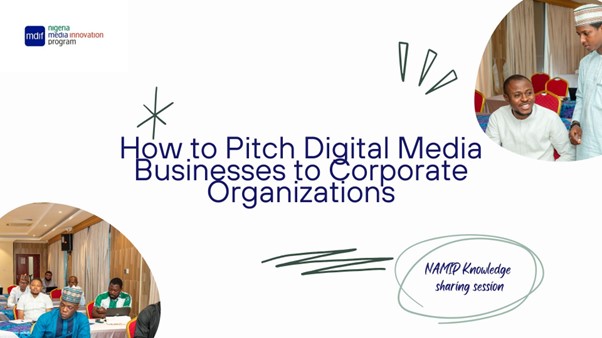By Temitayo Akinyemi
In an increasingly competitive landscape, digital media businesses must adapt their strategies to effectively pitch to corporate organizations. This was the focus of a recent NAMIP knowledge-sharing session led by Fu’ad Lawal, a media and technology professional with extensive experience at top digital media firms like Pulse, Red Media, and Big Cabal Media, as well as in leading business growth at startups. Fu’ad’s session provided a comprehensive overview of the key elements that can make digital media pitches more compelling to potential business partners, covering everything from optimizing ad formats to effectively closing sales.
Key Insights
- Leveraging Advertising Strategies: Fu’ad introduced two primary levers that digital media businesses can pull to boost revenue: increasing their audience reach and expanding the ad surface area on their platforms. Both are essential to striking a balance between audience growth and monetization. He emphasized that scaling requires strategic alignment between these two levers to maximize returns from digital advertising.
- Ad Formats and Their Effectiveness: The session provided an in-depth look at various advertising formats including display ads, native ads, and sponsored content. Display ads offer flexibility and easy scalability but often suffer from low conversion rates and face tough competition from tech giants like Google and Meta. Native ads, which blend seamlessly with editorial content, drive higher engagement but require creative consistency and may be viewed as deceptive by audiences. Sponsored content, while credible and engaging for brands, comes with high costs and uncertain returns.
- Optimizing Native and Sponsored Ads: Native ads have become a popular choice because of their ability to integrate with editorial content, resulting in better audience awareness and click-through rates. However, Fu’ad cautioned that native ads require continuous inventiveness and can be difficult to scale. Sponsored content, on the other hand, serves as a strong credibility booster for brands and tends to have a longer shelf-life. Despite these benefits, the ROI of sponsored content is not always guaranteed, making it essential for businesses to evaluate whether this format aligns with their overall goals.
- Sales and Pitching Strategies: Fu’ad stressed the importance of focusing on use cases rather than merely pitching products. Advertisers generally want one of two outcomes—awareness or conversions—and successful pitches should demonstrate how digital media offerings can deliver on these goals. Analytics play a vital role in reinforcing the pitch, providing data-backed proof of your platform’s effectiveness. Additionally, consistent follow-ups were highlighted as an often overlooked but crucial aspect of closing deals, especially in the competitive digital media environment.
- Pricing and Audience Metrics: Effective pricing strategies in digital media hinge on understanding audience engagement metrics and aligning your offerings accordingly. Businesses must be able to clearly communicate the value proposition of their audience size, engagement rates, and overall platform reach to prospective clients. By focusing on what advertisers care about most—engagement and conversion—media businesses can position themselves as valuable partners.
The session offered practical tools and actionable strategies to help digital media businesses refine their pitches and boost advertising revenue. By mastering both the traditional elements of sales and the nuances of digital media, organizations can better navigate the complex sales funnel and increase their success in closing deals. From understanding the unique strengths and weaknesses of different ad formats to tailoring pitches based on solid audience data, Fu’ad Lawal’s insights provided participants with a comprehensive guide to approaching corporate partners in today’s digital landscape.

